Acrobatic performances were also held in the "Cheng Peng" auditorium, at that time the new theatre for Chinese "autos". The "Cheng Peng" replaced the old tent which had fallen apart in front of the Má Koc Pagoda, as Adolfo Loureiro and Wenceslau de Moraes related in "Traços de Extremo-Oriente".
The "Cheng Peng" has always been a categorically Chinese theatre, and in the olden days its bill was a favourite among the population of the Bazaar. Actors such as Má Si Chang and, barring misinformation, the great Mei Lan Fong, performed there. These were the cream of the Cantonese theatrical art, the "Chinese auto". Worth remembering from those distant times is a highly unusual and symbolic ceremony staged after China became a republic, ousting for good the Manchurian Empire. The occasion, which must have had the aura of a momentous event, was the cutting of the braids or "pigtails" worn until then by Chinese men. All that remains of this significant ceremony, so full of local colour, is a rather dry announcement in A Verdade, January 7th, 1911:
For anyone studying this period, eager to unearth something new and original not easily reconstructed so long after the fact, this laconic rendering of events is sorely frustrating. We can only apologize for being unable to offer more on pain of slipping into the realm of fantasy.
There must have been other cinematographs, but no trace of them has survived save a vague reference to a certain "Olympia", situated on Rua do Hospital, now Rua Pedro Nolasco da Silva. However, as we said before, the cinematographs from this period were never more than dirty tents, which did not exactly invite the favours of the taipans and high society of the epoch, more accustomed to the comforts of the Dom Pedro V Theatre and the elegant soirées of Praia Grande, the Clube de Macau and the Military Club.
The first cinematograph to go by the name of "Vitória" was also a tent. It opened on January 9th, 1910 on the site that today houses the premises of the Municipal Technical Services on Rua do Dr. Soares, formerly Rua da Cadeia. This selfsame building was originally the residence of one of the most outstanding doctors in Macau, the late Dr. José Caetano Soares, a distinguished surgeon sadly missed. In the 18th-century, the said location was the site of the town prison, which was demolished on falling into a state of total disrepair, something nobody particularly missed. This vacant lot was eventually used as the pitching site for the cinema tent.
With regard to the opening night of the original "Vitória", what follows is a transcription from A Verdade, January 13th, 1910:
Once again, no words have been wasted on this announcement and there is scant leeway for enlarging upon them. We have no notion of the capacity or nature of the venue. We know nothing of the opening films or the impressions of the re porter. For the newspapers of the day cinema was below critical appraisal, unlike the recitals and concerts of the Dom Pedro V Theatre.
The new cinema cannot have scored an immediate success, since the management found it necessary to announce a number of times that it had: just received a new consignment of new films from America and Europe, and two or three of them will be included in each bill.
The bill in those early days consisted of eight short films which were changed every other day. To pull the crowds, the slogan about the prices went: the usual, the cheapest in the Far East.
1. Nick Carter and The Thieves.
2. The Madness of Cristalina.
3. The Living Topcoat (new).
4. Magic Love in Peril.
Towards the end of 1919, a new movie house opened, which went by the name "New Macau Theatre" or "Novo Teatro de Macau", located on the site of today's "Cinema Capitol". We know that the new cinematograph, catering to the tastes of the epoch, exhibited such sensational films as The Vampires in nine episodes and 27 parts, with actors Charles La Rue and Eugenie Aymé from the serial Fantomas, and Bound and Gagged, also divided into many episodes, with George B. Seitz and Marguerite Courtot in the leading roles.
A music recital featuring Italian and local artists took place in this cinematograph on June 3rd, 1920. The Italians were Signor D. F. Amelias, Mlle. Rosa Filócamo, Mlle. Elene Filócamo and Mme. A. Silvester. On the following day O Macaense reviewed this show as follows:
This movie house did not have an easy time of it. Towards the end of 1920 it took to closing its doors since the company that ran it could not meet the overheads. Sadly, O Macaense of October 13th commented: A sorry land it is where few and far between are the positive initiatives that do not founder.
It was evident that cinematographs labored under serious difficulties in the absence of custom from the Chinese population, who preferred the drama of the "autos" at the "Cheng Peng" and the attractions of the Bazaar. Depending almost solely on Portuguese custom, theirs was an uphill struggle short on profit. We were not able to ascertain how many cinematographs existed at this point in time. The "Vitória" continued to be the most important one, on account of its being the largest with the best films and centrally located. It was also the most popular. However, it went through similar straits, and on being unable to "meet the overheads," was not beyond cancelling new ventures.
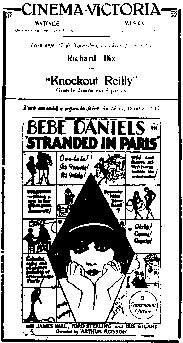 In 1919, the "Vitória" came under the management of Filipe Hung, a popular and sympathetic impresario who injected a great deal of dynamism into the cinematograph. He made every effort to satisfy his customers by finding out their preferences, choosing the best films, going to Hong Kong and consulting with the distribution companies in order to bring back magnificent productions, some of which were shown earlier here than in neighbouring colonies. Generous and profoundly Catholic, he often ran benefit sessions or dedicated the profits of a day's cinematographic show to brotherhoods or sports clubs. Today little remains of this spirit of enterprise, of which O Macaense, October 5th, 1919, had the following to say:
We were informed that the liquid profits of the cinematographic shows of the first night of the current month was $240 (substantial takings for the epoch), a sum which, by kind intervention of the new management of the Animatógrafo Vitória, will be given to the Council of the Brotherhood of Our Lady of the Rosary towards the cost of work being undertaken in the church of San Domingos.
There were two cinematographic sessions and the second, which we attended, was given to a literally full house. The Municipal Band played, and won a warm round of applause from the audience for its faultless. performance under the masterly baton of Sr. Alessio Benis.
Remembered even today traversing the city in his famous side-car, Filipe Hung let go of the "Vitória" towards the end of 1921. On February 3rd, he opened "Animatógrafo Macau" on premises which years earlier had housed the "New Macau Theatre". He gave notice of this in the newspapers in the following manner:
The work undertaken has made of this Animatógrafo the best movie house of the colony.
Always on show are the best and most recent films of the famed houses Universal, Paramount, etc....
Change of programme four times a week, Monday, Wednesday, Friday and Saturday.
Come to the most popular Animatógrafo in Macau
The departure of Filipe Hung did not signal the close of the "Vitória". On March 3rd, 1922, a new company began its own venture with a special vaudeville programme of pantomime and song, concluding with a cinematographic exhibition. The programme opened with the "star turn of the Cosmopolitan Vaudeville presenting the Great Garcia Troup, with athletes of world renown, whose marvelous and daring feats have been performed in all the principal theatres of Europe." Following this came a novelty, a comic pantomime by Bumps and Co.. Next on the bill was Nina, The Girl with Personality, with new "songs" and original dances. All "Chic! Fascinating! Delightful!." The programme concluded with a film featuring Norma Talmadge in the "sensational drama" Passion Flower.
Such auspicious beginnings for the two movie houses gave way to financial troubles linked to local politics. The year 1922 was the tragic year of the "Chip Seng" incident and the general strike, which cast a dark shadow over relations between the Portuguese and the Chinese, bringing the city to a complete standstill. The "Vitória", for reasons we were not able to clarify, was even the target of a bomb attack which shattered the windows of its façade, although fortunately without causing, any deaths. However, this was also the year in which the Portuguese of Macau, Hong Kong and Shanghai were seized by a wave of heady patriotism, when Portugal's name acquired a prestigious ring in these parts after the flight across the South Atlantic by Gago Coutinho and Sacadura Cabral. It was also the year, if our research is correct, in which the Dom Pedro V Theatre experienced one of the most brilliant pinnacles in its history, with the presentation of a new Italian opera company on the initiative once again of Júlio António Eugénio da Silva.
When Luso-Chinese relations were normalized and calm fell once again, life began where it had left off. In this new chapter of the cinema, the two above-mentioned movie houses vied for primacy in the public eye. Filipe Hung's spirit of enterprise led him to put up a tent beside a lake situated on roughly the same spot where today stand the houses of the civil servants on the Avenida Coronel Mesquita, which at the time was a pleasant and tree-lined suburb with stretches of rural Chinese landscape. There, in the summer months, especially when the heat closed in, there were cinema shows, food and drinks, fairground games and rowing boats on a lake.
In 1919, the "Vitória" came under the management of Filipe Hung, a popular and sympathetic impresario who injected a great deal of dynamism into the cinematograph. He made every effort to satisfy his customers by finding out their preferences, choosing the best films, going to Hong Kong and consulting with the distribution companies in order to bring back magnificent productions, some of which were shown earlier here than in neighbouring colonies. Generous and profoundly Catholic, he often ran benefit sessions or dedicated the profits of a day's cinematographic show to brotherhoods or sports clubs. Today little remains of this spirit of enterprise, of which O Macaense, October 5th, 1919, had the following to say:
We were informed that the liquid profits of the cinematographic shows of the first night of the current month was $240 (substantial takings for the epoch), a sum which, by kind intervention of the new management of the Animatógrafo Vitória, will be given to the Council of the Brotherhood of Our Lady of the Rosary towards the cost of work being undertaken in the church of San Domingos.
There were two cinematographic sessions and the second, which we attended, was given to a literally full house. The Municipal Band played, and won a warm round of applause from the audience for its faultless. performance under the masterly baton of Sr. Alessio Benis.
Remembered even today traversing the city in his famous side-car, Filipe Hung let go of the "Vitória" towards the end of 1921. On February 3rd, he opened "Animatógrafo Macau" on premises which years earlier had housed the "New Macau Theatre". He gave notice of this in the newspapers in the following manner:
The work undertaken has made of this Animatógrafo the best movie house of the colony.
Always on show are the best and most recent films of the famed houses Universal, Paramount, etc....
Change of programme four times a week, Monday, Wednesday, Friday and Saturday.
Come to the most popular Animatógrafo in Macau
The departure of Filipe Hung did not signal the close of the "Vitória". On March 3rd, 1922, a new company began its own venture with a special vaudeville programme of pantomime and song, concluding with a cinematographic exhibition. The programme opened with the "star turn of the Cosmopolitan Vaudeville presenting the Great Garcia Troup, with athletes of world renown, whose marvelous and daring feats have been performed in all the principal theatres of Europe." Following this came a novelty, a comic pantomime by Bumps and Co.. Next on the bill was Nina, The Girl with Personality, with new "songs" and original dances. All "Chic! Fascinating! Delightful!." The programme concluded with a film featuring Norma Talmadge in the "sensational drama" Passion Flower.
Such auspicious beginnings for the two movie houses gave way to financial troubles linked to local politics. The year 1922 was the tragic year of the "Chip Seng" incident and the general strike, which cast a dark shadow over relations between the Portuguese and the Chinese, bringing the city to a complete standstill. The "Vitória", for reasons we were not able to clarify, was even the target of a bomb attack which shattered the windows of its façade, although fortunately without causing, any deaths. However, this was also the year in which the Portuguese of Macau, Hong Kong and Shanghai were seized by a wave of heady patriotism, when Portugal's name acquired a prestigious ring in these parts after the flight across the South Atlantic by Gago Coutinho and Sacadura Cabral. It was also the year, if our research is correct, in which the Dom Pedro V Theatre experienced one of the most brilliant pinnacles in its history, with the presentation of a new Italian opera company on the initiative once again of Júlio António Eugénio da Silva.
When Luso-Chinese relations were normalized and calm fell once again, life began where it had left off. In this new chapter of the cinema, the two above-mentioned movie houses vied for primacy in the public eye. Filipe Hung's spirit of enterprise led him to put up a tent beside a lake situated on roughly the same spot where today stand the houses of the civil servants on the Avenida Coronel Mesquita, which at the time was a pleasant and tree-lined suburb with stretches of rural Chinese landscape. There, in the summer months, especially when the heat closed in, there were cinema shows, food and drinks, fairground games and rowing boats on a lake.
 They are first-class showmen with all the advantages of possessing the true touch of Alabama. They have performed throughout the Philippines over the last three years, to the widespread delight of audiences.
To a great fanfare, a certain Murray arrived to perform in Macau, of whom subsequently we have never heard mention. The "Vitória" announcement of April 1st and 2nd 1925 for the 9:30 and 2:30 sessions on Thursday cried out:
Novelty! Marvel! Mystery!
A great double attraction. A splendid film and a Vaudeville turn of the highest quality.
The first of Murray's shows, an Australian Escape Artist, in 'The Mystery of the 5000 Dollar Suitcase', 'The Man They Couldn't Hang', and many other tricks.
Murray can break free from any padlock, rope, handcuffs or chests that the public cares to bring along (sic).
Come and see the display of "chains," handcuffs and straitjackets in the auditorium.
Don't miss this opportunity! Not to be missed!
Admission prices - 9:30 and 2:30, 80 and 60 'avos'.
In the newspaper O Combate, the following sensational news item came out on the same day:
Important! Free attraction. At 6 o'clock on Wednesday April 1st, Murray will hang himself from the walls of this theatre, on the Avenida Almeida Ribeiro side (exterior). All welcome. Seeing is believing.
This was evidently a practical joke by the newspaper, since it was "April Fool's Day". The paper must have enjoyed no end the sight of gaping crowds waiting for a show that never happened. And we can picture Murray's embarrassment on having to deny the hoax. Between September 30th and October 2nd, 1926 "The Stravinaki Dancers" put on what can only have been lovely performances. At the time, there were many groups; choral, musical; folkloric and dance, composed of White Russians fleeing the Bolshevik Revolution of 1917. They were earning their living by performing in the principal centres of the Far East, those with substantial European communities, such as Shanghai, Tientsin, Tsingtao, Canton, Hong Kong, Hanoi, Saigon, Singapore, and Batavia (Djkarta).
"The Stravinaki Dancers" were composed of 20 artists and 15 "beautiful girl dancers" and they presented various numbers of artistic ballets.
Amongst the most applauded were "The Tavern of Death", "Parisian Nights", "The Tango of Love" and "Valencia".
In 1927, the "Vitória" continued to offer non-cinematographic shows. In January the programme was as follows:
The well-known Chinese athlete Tong-Man-Tien, who has returned from a triumphant tour of Europe and America, will give three sensational performances in this theatre, assisted by Hong-Tong-Hói, Ló-Sin-Kiu, Chong-Kam-Kwan.
Tong-Man-Tien, of amazing resilience, permits an automobile containing 16 people to drive over his body.
He bends with consummate ease an iron bar weighing 50 pounds. He can jump 50 feet into the air.
One of the best artists from China, Kong-Tong-Hói, the amazing imitator of Charlie Chaplin, will keep the audience's sides splitting.
Come and see! Come and see!
On March 3rd, 1927, the first Grand Boxing Championship took place between local fighters, featuring among others Pinto da Silva against Iron Bux (10 rounds) and João da Conceição against Kind Raymond (8 rounds). Pinto da Silva and João da Conceição sparred in other boxing matches, delighting crowds, who showered them with applause and discussed their favourites at length.
They are first-class showmen with all the advantages of possessing the true touch of Alabama. They have performed throughout the Philippines over the last three years, to the widespread delight of audiences.
To a great fanfare, a certain Murray arrived to perform in Macau, of whom subsequently we have never heard mention. The "Vitória" announcement of April 1st and 2nd 1925 for the 9:30 and 2:30 sessions on Thursday cried out:
Novelty! Marvel! Mystery!
A great double attraction. A splendid film and a Vaudeville turn of the highest quality.
The first of Murray's shows, an Australian Escape Artist, in 'The Mystery of the 5000 Dollar Suitcase', 'The Man They Couldn't Hang', and many other tricks.
Murray can break free from any padlock, rope, handcuffs or chests that the public cares to bring along (sic).
Come and see the display of "chains," handcuffs and straitjackets in the auditorium.
Don't miss this opportunity! Not to be missed!
Admission prices - 9:30 and 2:30, 80 and 60 'avos'.
In the newspaper O Combate, the following sensational news item came out on the same day:
Important! Free attraction. At 6 o'clock on Wednesday April 1st, Murray will hang himself from the walls of this theatre, on the Avenida Almeida Ribeiro side (exterior). All welcome. Seeing is believing.
This was evidently a practical joke by the newspaper, since it was "April Fool's Day". The paper must have enjoyed no end the sight of gaping crowds waiting for a show that never happened. And we can picture Murray's embarrassment on having to deny the hoax. Between September 30th and October 2nd, 1926 "The Stravinaki Dancers" put on what can only have been lovely performances. At the time, there were many groups; choral, musical; folkloric and dance, composed of White Russians fleeing the Bolshevik Revolution of 1917. They were earning their living by performing in the principal centres of the Far East, those with substantial European communities, such as Shanghai, Tientsin, Tsingtao, Canton, Hong Kong, Hanoi, Saigon, Singapore, and Batavia (Djkarta).
"The Stravinaki Dancers" were composed of 20 artists and 15 "beautiful girl dancers" and they presented various numbers of artistic ballets.
Amongst the most applauded were "The Tavern of Death", "Parisian Nights", "The Tango of Love" and "Valencia".
In 1927, the "Vitória" continued to offer non-cinematographic shows. In January the programme was as follows:
The well-known Chinese athlete Tong-Man-Tien, who has returned from a triumphant tour of Europe and America, will give three sensational performances in this theatre, assisted by Hong-Tong-Hói, Ló-Sin-Kiu, Chong-Kam-Kwan.
Tong-Man-Tien, of amazing resilience, permits an automobile containing 16 people to drive over his body.
He bends with consummate ease an iron bar weighing 50 pounds. He can jump 50 feet into the air.
One of the best artists from China, Kong-Tong-Hói, the amazing imitator of Charlie Chaplin, will keep the audience's sides splitting.
Come and see! Come and see!
On March 3rd, 1927, the first Grand Boxing Championship took place between local fighters, featuring among others Pinto da Silva against Iron Bux (10 rounds) and João da Conceição against Kind Raymond (8 rounds). Pinto da Silva and João da Conceição sparred in other boxing matches, delighting crowds, who showered them with applause and discussed their favourites at length.
.</figcaption></figure>
<p>
The great contender to João da Conceição was António Jesus Placé, better known as Padeiro, and the two fought great comeback fights which continued into the first years of the thirties. The fights between these two sent waves of excitement throughout the whole city and created as much interest and enthusiasm as the football matches between those two legendary rival teams, the "Argonauts" and the "Shadows".
</p>
<p>
As a little detour from our main theme, let us take a look at their greatest fight, which took place in the "Vitória" in February of 1931. This we do in homage to these two great sportsmen from Macau, sadly deceased, and as a toast to their many friends. On the tenth of that month, a letter appeared in the <i>Jornal de Macau</i>, stating: <i>I, António Placé, 150 lb., challenge Sr. João da Conceição, the well-known and famed boxer, to join me in the ring on the 12th of the current month in the Vitória Theatre. </i>
</p>
<p>
This did not fall on deaf ears, and João da Conceição responded proudly on the 12th and in the same paper:
</p>
<p>
<i>In reply to the challenge issued by Sr. António Placé in the latest copy of the newspaper of which Your Excellency is the esteemed director, it behooves me to respond that I cannot accept the challenge on the date proposed on account of an unforeseen engagement. However, the match can take place within the next two weeks, that is, on February 23rd, at 9:30, provided this is convenient for my adversary and the Ring can be arranged in the Vitória Theatre. If, as I expect, I am victorious in this match I will challenge any fighter of my weight (140 lb.). </i>
</p>
<figure><img src=) The city was thrown into uproar and the supporters of each fighter took extreme positions in defense of their man. We were only young, but we nevertheless remember a lively exchange of words between two fans, who vaunted the qualities of their chosen fighters, their muscles and their upper-cut.
The fight finally took place on the 28th of that month, and the judges were Artur T. Borges, Manuel Soares and Augusto Marques, who decided in favour of João da Conceição. The Jornal de Macau of March 3rd told of events in the ring:
The fight took place during the interval of a cinematographic show, in an improvised ring which was somewhat quickly thrown together, it seems. The fighters were greeted with a round of applause on entering the ring. They commenced the match, with much enthusiasm and brimming with energy, and Sr. João da Conceição demonstrated better technique and fighting style than his opponent, who revealed all the qualities of a good fighter but was beaten in every round save the second, which was classified a draw. Sr. Mário Miranda was a sound referee.
Good times they were indeed, when Macau shook with the contests of two popular and lovable fighters! On the subject of 1927, the "Vitória" booked a telepathy and hypnosis show for April 11th and 12th for the 9:30 session. The famous Prof. Harry Pisler had been a great success in Europe, Algiers, Tunisia, Morocco and Turkey. He was to offer scientific experiences of strange phenomena involving thought reading, self-induced anesthesia, animal hypnosis, self-hypnotism, occult sciences, human petrifaction, temporary death and telepathic catalepsy.
The programme prudently advised:
The greatest minds in the world have shown interest in the experiences presented by Prof. Pisler. The best newspaper in the world gave Prof. Pisler the very best of write-ups. All Doctors and Professors are requested to observe these scientific experiences of strange phenomena. If any spectator would like to pose questions or explanations, he is requested to do so in writing or arrange an appointment after the show. The true scientific nature of these experiences means that Prof. Harry Pisler, a genuine medium, should not be confused with commonplace charlatans.
PS. Prof. Harry Pisler requests absolute silence during his experiences.
The newspapers of the period make no reference to these scientific experiences of strange phenomena. Thus we have no way of knowing whether some professor or doctor took it upon himself to observe these experiences, or whether anybody requested an interview with the said Professor after the performance.
The rostrum of the "Vitória" also provided a venue for classical music concerts. On the same day that Joseph Borissov, a violinist, was playing in the Dom Pedro V Theatre, August 9th, 1927, Leo Podobsky, a pianist, gave a concert in the "Vitória". Alongside Leo Podobsky, Vera Mirova, "premiere dancer", performed a series of classical dance routines. In the same year, other classical dances reached the "Vitória" with Professor C. Theresis and Mlle. Marguerite Senour, who were a sensation on account of the perfection with which they brought off their complicated steps. The "Vitória" had two very special nights of classical music, with performances by the two Kitan bothers Robert (on the violin) and Anatole (on the piano), on February 21st and 22nd, 1928. The brothers were disciples of the two great masters, Omar and Joseph Heifetz, and they enchanted audiences with beautiful compositions from their vast repertoire. Noteworthy also was the second Musical Recital (we were not able to ascertain where the first one took place) on March 9th, 1928 by the distinguished Professor Harry Ore and the Town Band of Macau, under the direction of Constâncio José da Silva, a music enthusiast. This recital was given in the presence of the Governor and his family, and other dignitaries, and received a big round of applause. The "Vitória" doubtless offered other shows to the people of Macau before the advent of the 'talkies', but we have not been able to gather any definite details. On pain of historical falsification, it is preferable that we leave aside these performances which are not pertinent to the cinema. In spite of such shows, the "Vitória" was in essence a movie house. And if our main theme is the "Vitória", this is because it was here that the very best silent films were exhibited, and no other cinematograph could compare. At the turn of the twenties, serial films had produced another great heroine, Ruth Roland (Ruth of the Rockies), who took the place of Pearl White. She had withdrawn from the world of the cinema and was now in Europe enjoying the vast wealth she amassed from her enormous successes: Perils of Pauline and Exploits of Elaine. Elmo Lincold was the Tarzan of the times (Tarzan of the Apes, The Romance of Tarzan). Mary Pickford, the Universal Sweetheart, was at the high point of her career with Pollyana, The Hoodlum and Daddy Long Legs. The most prominent romantic male lead of the time was Antonio Moreno (The Spanish Dancer). The sisters Constance and Norma Talmadge, on the one hand, and the sisters Lillian and Dorothy Gish, on the other, were the innocent victims in tearjerkers and their trials and tribulations were the source of many a weeping cinema enthusiast. Not to be forgotten were also Clara Kimball Young and Betty Compson.
The city was thrown into uproar and the supporters of each fighter took extreme positions in defense of their man. We were only young, but we nevertheless remember a lively exchange of words between two fans, who vaunted the qualities of their chosen fighters, their muscles and their upper-cut.
The fight finally took place on the 28th of that month, and the judges were Artur T. Borges, Manuel Soares and Augusto Marques, who decided in favour of João da Conceição. The Jornal de Macau of March 3rd told of events in the ring:
The fight took place during the interval of a cinematographic show, in an improvised ring which was somewhat quickly thrown together, it seems. The fighters were greeted with a round of applause on entering the ring. They commenced the match, with much enthusiasm and brimming with energy, and Sr. João da Conceição demonstrated better technique and fighting style than his opponent, who revealed all the qualities of a good fighter but was beaten in every round save the second, which was classified a draw. Sr. Mário Miranda was a sound referee.
Good times they were indeed, when Macau shook with the contests of two popular and lovable fighters! On the subject of 1927, the "Vitória" booked a telepathy and hypnosis show for April 11th and 12th for the 9:30 session. The famous Prof. Harry Pisler had been a great success in Europe, Algiers, Tunisia, Morocco and Turkey. He was to offer scientific experiences of strange phenomena involving thought reading, self-induced anesthesia, animal hypnosis, self-hypnotism, occult sciences, human petrifaction, temporary death and telepathic catalepsy.
The programme prudently advised:
The greatest minds in the world have shown interest in the experiences presented by Prof. Pisler. The best newspaper in the world gave Prof. Pisler the very best of write-ups. All Doctors and Professors are requested to observe these scientific experiences of strange phenomena. If any spectator would like to pose questions or explanations, he is requested to do so in writing or arrange an appointment after the show. The true scientific nature of these experiences means that Prof. Harry Pisler, a genuine medium, should not be confused with commonplace charlatans.
PS. Prof. Harry Pisler requests absolute silence during his experiences.
The newspapers of the period make no reference to these scientific experiences of strange phenomena. Thus we have no way of knowing whether some professor or doctor took it upon himself to observe these experiences, or whether anybody requested an interview with the said Professor after the performance.
The rostrum of the "Vitória" also provided a venue for classical music concerts. On the same day that Joseph Borissov, a violinist, was playing in the Dom Pedro V Theatre, August 9th, 1927, Leo Podobsky, a pianist, gave a concert in the "Vitória". Alongside Leo Podobsky, Vera Mirova, "premiere dancer", performed a series of classical dance routines. In the same year, other classical dances reached the "Vitória" with Professor C. Theresis and Mlle. Marguerite Senour, who were a sensation on account of the perfection with which they brought off their complicated steps. The "Vitória" had two very special nights of classical music, with performances by the two Kitan bothers Robert (on the violin) and Anatole (on the piano), on February 21st and 22nd, 1928. The brothers were disciples of the two great masters, Omar and Joseph Heifetz, and they enchanted audiences with beautiful compositions from their vast repertoire. Noteworthy also was the second Musical Recital (we were not able to ascertain where the first one took place) on March 9th, 1928 by the distinguished Professor Harry Ore and the Town Band of Macau, under the direction of Constâncio José da Silva, a music enthusiast. This recital was given in the presence of the Governor and his family, and other dignitaries, and received a big round of applause. The "Vitória" doubtless offered other shows to the people of Macau before the advent of the 'talkies', but we have not been able to gather any definite details. On pain of historical falsification, it is preferable that we leave aside these performances which are not pertinent to the cinema. In spite of such shows, the "Vitória" was in essence a movie house. And if our main theme is the "Vitória", this is because it was here that the very best silent films were exhibited, and no other cinematograph could compare. At the turn of the twenties, serial films had produced another great heroine, Ruth Roland (Ruth of the Rockies), who took the place of Pearl White. She had withdrawn from the world of the cinema and was now in Europe enjoying the vast wealth she amassed from her enormous successes: Perils of Pauline and Exploits of Elaine. Elmo Lincold was the Tarzan of the times (Tarzan of the Apes, The Romance of Tarzan). Mary Pickford, the Universal Sweetheart, was at the high point of her career with Pollyana, The Hoodlum and Daddy Long Legs. The most prominent romantic male lead of the time was Antonio Moreno (The Spanish Dancer). The sisters Constance and Norma Talmadge, on the one hand, and the sisters Lillian and Dorothy Gish, on the other, were the innocent victims in tearjerkers and their trials and tribulations were the source of many a weeping cinema enthusiast. Not to be forgotten were also Clara Kimball Young and Betty Compson.

Charles Chaplin, a Western favourite actor of Macau Chinese, in the film The Gold Rush.
As the twenties progressed the "femmes fatales" appeared, blood chilling man-eaters whose names were on the tip of everybody's tongue: Gloria Swanson, Theda Bara, Nazimova, Barbara LaMarr, Pola Negri and Mae Murray. With his manly moustache and wide ironic smile, Douglas Fairbanks was the swashbuckling supremo, not to be equalled until the advent of the 'talkies', when Errol Flynn came along. Fairbanks is truly unforgettable with his sword and acrobatics, in The Thief of Bagdad, The Mark of Zorro, The Three Musketeers, The Iron Mask, Robin Hood and The Black Pirate. This latter film was in colour, the first experiment with the Technicolour system.
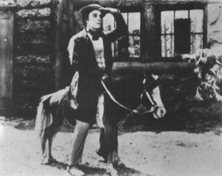
Buster Keaton, in the film Our Hospitality.
Fairbanks was so popular among the young men of Macau that in the days following the performances of his films all the bamboo poles from the gardens, orchards and farms would vanish across the city and its outskirts. They had been marshalled for use as sabers for the sword fights of the rival gangs of young boys, to the detriment of their eyes and the desperation of the numerous gardeners and farmers to be found at the time in this City of the Name of God. The hilt guard of these improvised swords was made from a grapefruit skin. It was beyond doubt Fairbanks who finally pulled the Chinese crowds in Macau, which up to this point had remained so loyal to the pleasures of the Bazaar and the 'autos' of the Cheng Peng. Fairbanks and Charlie Chaplin.
In the twenties that great dynasty of the theatre and the film world, the Barrymores (Ethel, Lionel and John) entered the annals of history. This distinguished family circle was to be joined by one of the most beautiful faces in Hollywood, Dolores Costello, the future wife of John and daughter of the famous Maurice Costello. John Barrymore had a classic profile, "the great profile", and his films in this period, of immense popularity, were Dr. Jeckyll and Mr. Hyde, Beau Brummel, The Beloved Rogue and Don Juan. The greatest screen cowboy, William S. Hart (The Desert Man, The Gun Fighter), who was unequaled in the first decade of this century, now began to lose preeminence. In his place came Tom Mix, Tim McCoy, "Buck" Jones, Jack Hoxie and on a less prominent note, Jack Holt, Ken Maynard and Thomas Meighan, who played the lead role in one of the best Westerns of the silent screen, The Alaskan, which first opened in Macau on October 7th, 1927.
Film comedies, which engendered so many hours of sheer escapism, laughter and happiness, were the domain of that famous triumvirate of the silent screen: Charlie Chaplin ('Chariot'), Harold Lloyd and Buster Keaton ('Pamplinas'). The best of these was surely 'Chariot'. His screen appearances, even in two-part films, used to fill the house at the "Vitória". The Chinese simply adored him. The Gold Rush was in our opinion his best film of the twenties, and left an indelible mark among the people of Macau. We were only boys, but we still remember 'Chariot' eating his own boots to overcome hunger. At the time we laughed with all the other children. Only later, on returning to the film with adult eyes, did we understand in all its implications the moving and humanistic dimensions of the Chaplinesque message.
It was Chaplin who brought to light the child-prodigy of the silent movies, Jackie Coogan, in The Kid, that touching, cute-faced little boy who has now turned into an unprepossessing and bald old man playing small parts for television. Under Chaplin's magic touch, Jackie Coogan came to be known as "the greatest boy-actor in the world" and was later the protagonist of the magnificent silent version of Oliver Twist, "the greatest film triumph of the decade," in which he appeared alongside Lon Chaney. In Macau the film was to have its debut on November 3rd, 1926.
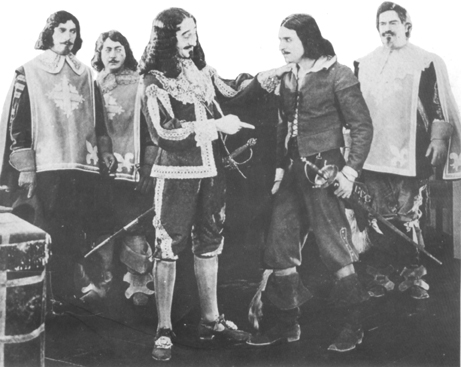
Douglas Fairbanks (centre, right), in The Three Musketeers, in the role of D'Artagnan.
Harold Lloyd was one of the biggest laughmakers of the comic film and his films were sell-out performances at the "Vitória". As soon as he appeared on screen, the auditorium was filled with chuckles. His imitations were irresistible. The clown with the super-famous specs became a favourite of ours in films like The Freshman, For Heaven's Sake and Hot Water. Buster Keaton ('Pamplinas') was just as popular, with his sad and impassive face void of even a hint of a smile. The situations he created, of peerless hilarity, never fade from memory. Who could forget, for example, his film Go West and the affection he harboured for his cow? But this triumvirate alone did not have exclusive rights to comedy in the years of the silent screen. The twenties ushered in the side-splitting films of Mark Sennett, in two parts, with Ben Turpin in the lead role. There was Eddie Boulden and Harry Langdon. Marie Dressler and Polly Moran. There was that group of young whippersnappers who provided many generations with a good laugh, Our Gang, with Mickey Daniels, Jackie Condon, Sunshine Sammy, Fat Joe Cobb, Farina, Mary Kornman, the dog Pete and Jackie Davis. Later, the gang would be joined by Jean Darling, Stymie, Johnny Downs and Jackie Cooper. In the last days of the silent movies Oliver Hardy (‘Bucha') and Stan Laurel (‘Estica') become important screen personalities, known in Macau by the names ‘Gordo' (Fatso) and ‘Magro' (Skinny). Then there was the huge Karl Dane and the tiny George K. Arthur. And we should not forget Charley Chase, unjustly overlooked in the anthologies on comic films, who was always very spruce, with moustache and glasses, unfailingly elegant even in the most unlikely scenarios. A clown in the best tradition of Mark Sennett. It was one wholehearted laugh after another, good old fashioned fun in an epoch untrammeled by worries.
The silver screen of the "Vitória" saw the films of the grand master of cinema, David W. Griffith. The first was The Birth of a Nation, one of the all-time greats. Intolerance, another classic work, opened in Macau in May 1923 and the "Vitória" announcements included the following:
Love-lorn battles across the centuries, with an introduction and 2 acts (13 long parts). This film production took three years and cost $2,000,000.00, employing 25,000 people, 7,500 horses, 1,500 carriages and a banquet room a mile long.
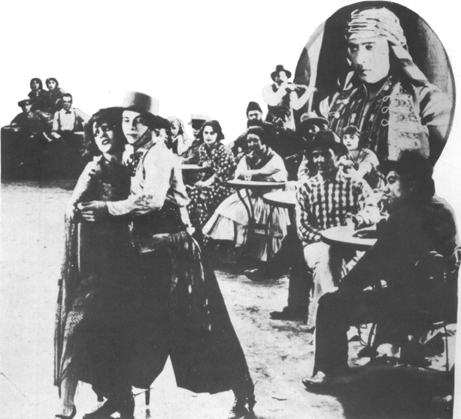
Rudolfo Valentino, the Great Lover in the movies of the 20's, in the film The Son of the Sheik.
Many other films of Griffith were to follow, such as Idol Dancer, The Way Down East and Orphans in the Storm, and this last film is also considered one of the best films of the silent screen. Griffith's favourite actresses were the Gish sisters, Lillian and Dorothy, especially the first, the sweet heroine of The Birth of a Nation. The debut of Intolerance was so important in Macau that the company contracted the Coronet orchestra from Hong Kong with a view to playing music befitting the film. In 1923, the same year as Intolerance, an actor took the "Vitória" auditorium by storm in a stunning film which must have engraved itself on the minds of its contemporaries. The leading man's profile was not altogether unknown, but until then he had acted only in run-of-the-mill films, a handsome face but just one among many. This actor, as some readers will have already guessed, was the heart throb Rudolf Valentino and the film, The Four Horsemen of the Apocalypse, based on the famous book by Blasco Ibañez.
The film arrived to world-wide acclaim and in Hong Kong was an overnight sensation. The "Vitória" management, anxious to please its audiences, contracted the Star orchestra from Kowloon to play the accompanying musical score. It was in this film that we saw the tango danced for the first time in all its vim and vigor, a novelty for local audiences, a torrid, sensual and scandalous dance. The orchestra synchronized the music with the movements of Valentino and Alice Terry. Accustomed as we are to soundtrack, we cannot imagine what such a synchronization must have meant, but doubtless our parents and grandparents gave a big hand to this type of presentation. This film gave birth to the tango craze in Macau, paving the way for its admission into the ballroom of the Clube de Macau without the necessity of its running the gauntlet of that eternal group of ladies with their lorgnettes raised, arching their eyebrows and scratching their heads in disapproval.
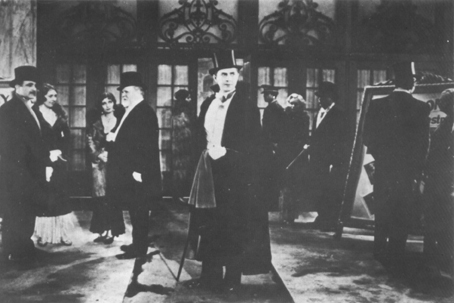
Bela Logosi, in the role of Count Dracula, who frightened audiences throughout the whole world.
Valentino was a phenomenon of the heady decade of the twenties, the famous "Roaring Twenties", the halcyon days of jazz and the Charleston, Prohibition, Al Capone and the Chicago gangsters, the lost generation, the insane speculating that would culminate in the disastrous "crack" of the New York Stock Exchange. When he made his appearance in The Four Horsemen of the Apocalypse, in close-up, dressed in gaucho attire with his deadly smile and seductive eye devouring the vulnerable Alice Terry, Valentino was instantaneously the idol of the moviegoers. Producers who for so long had scarcely given the actor a second thought now saw in him as a veritable gold mine. Valentino was on the tip of every girl's tongue and lodged deep in her heart.
Any man with a roving eye began to wear his hair a la Valentino, dress a la Valentino, emulate Valentino's gestures, the look in his eyes and his smile. Born of a singular epoch, he became the paragon of masculinity. With him came the myth of the Latin lover, the amorous and demonic Latin, gentle but rough, generous but cruel, ardent and punishing. Other Mediterranean actors basked in the light reflected from this image of the "Latin lover" essentialized by Valentino. A case in point would be Antonio Moreno, already a veteran, or Ramon Novarro, at the dawn of his career, both of whom rose to stardom.
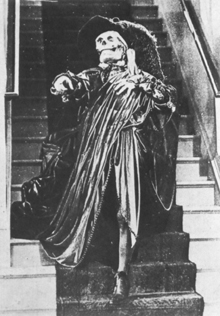
Lon Chaney, in The Phantom of the Opera.
Valentino's films were always something of an event. The shows were awaited with bated breath and on the opening night the cream of Macau was to be found in the "Vitória". Marveled at in turn were A Sainted Devil with Nita Naldi, the immortal The Sheik, with Agnes Ayres, the torrid Camille, with Nazimova.
Valentino's premature death in 1926 shocked the world. The traffic in Time Square, Broadway, in the heart of New York, came to a halt, as women broke down in the open street gripped by hysteria and fainting fits. Macau was much more measured in its grief, but many a girl and woman discreetly donned black dress. When his films were shown in the wake of his death, such as Monsieur Baucaire, The Eagle, The Son of the Sheik and Cobra, they continued to be an undeniable success, with fans lamenting the loss of the "man of their dreams". Valentino's disappearance from the ambit of the cinema allowed others actors to rise to stardom, but none succeeded in taking his place. He left, so to speak, a gap. The male stars who drew most benefit from this situation were, above all, Ramon Novarro and John Gilbert and also Monte Blue and Rod La Rocque.
Horror films and films of the fantastic were concentrated in the hands of The Man of a Thousand Faces, the silent version of someone who in the 'talkies' would be Bela Lugosi (Dracula) and Boris Karloff (Frankenstein and Mummy). Versatile and wholly dedicated to his art, to the point of ruining his health on account of it, Lon Chaney embraced the widest range of macabre roles: psychopath, murderer, ghost, monster, hard-hearted gangster, a deformed and repellent figure, etc.. He was the uncontested king of this film genre. We are not going to enumerate all the films by this great actor, but in the memory of the people of Macau The Phantom of the Opera lives on. When his terrifying mask appeared on screen, a fearful silence would fall in the "Vitória", and some would bury their head in their hands to quell the fear.
The silent movies included an adventure film serial the main protagonist of which was an immense box-office success at the "Vitória", a police dog. As our readers might have guessed, the dog in question was Rin-Tin-Tin, who supplied his owner with a small fortune - 400 dollars a week, a tidy sum of money for the time. The 'talkies' would sign another canine hero, Lassie, who, however, was never to reach the same kind of stardom as Rin-Tin-Tin, the most memorable dog actor in the cinema.
In the second half of the twenties, the screen at the "Vitória" provided fleeting glimpses of faces only to become genuine stars in sound motion pictures, such as Gary Cooper, Joan Crawford, Clark Gable, Norma Shearer, Loretta Young, Kay Francis, Nancy Carroll, Myrna Loy, John Wayne, William Powell, Gilbert Roland, Constance and Joan Bennett, Jean Arthur, Richard Arlen, Lew Ayres, Charles Buddy Rogers, Charles Farrell, Janet Gaynor, etc..
Not to be forgotten, meanwhile, are some of the starlets who enjoyed great esteem among the public during the silent years and who disappeared with the advent of the 'talkies': Clara Bow, the highly sensual It Girl, Laura La Plante (Show Boat) and Renée Adorée, the beautiful innocent of The Big Parade. And the actors Richard Barthelmess (Dawn Patrol), Richard Dix (Cimarron), George Bankcroft (Underground) and George O'Brien, the favourite performer in films based on the novels of Zane Grey, paired with Mary Brian.
The religious films of Cecil B. de Mille are never far from our minds, such as The Ten Commandments and his masterpiece The King of Kings. In those days the management of the "Vitória" ran this type of film during the Easter period, respecting the sentiments of the Catholic population. The King of Kings, narrating the Passion of Christ, had such an impact that there were countless repeat performances. The scenes of the Via Dolorosa and the Crucifixion brought tears to the eyes of the spectators. The story goes that one elderly lady, on contemplating Christ's bloodstained countenance labouring under the burden of the cross, portrayed with such feeling by H. B. Warner, broke down and letting out a plaintive lament, whispered, greatly moved: "Oh, how like Jesus...."
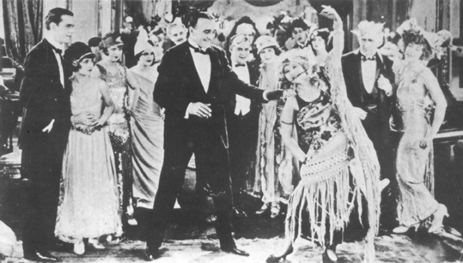
A scene from the film The Gold Diggers, with Wyndham Standing and Louise Fazenda.
The first version of Ben Hur, another religious film, was also a watershed in the history of the silent cinema, with Ramon Novarro in the leading role and Francis X. Bushman as Messala. No slight is intended against the magnificent sound version, by William Wyler, which was released in the sixties and earned innumerable Oscars. But the fact is that the talkie, for all its technical sophistication and visual splendour, did nothing to efface the grandeur of the first Ben Hur. Bushman's Messala, with his cruelty and calculating nature, far surpassed Stephen Boyd's interpretation. The miracle scene, when Jesus passes his blanched hand over the heads of the lepers, greatly exceeded in feeling the depiction of the second version, and went straight to the viewer's heart.
During the twenties, the blood bath of 1914-1918 was never far from thought. Patriotic fervor was the chief characteristic of war films in the first years of the twenties. The Allied Forces always representing the side of justice and righteousness, the Germans and Austrians always representing tyrants and brutes. The public soon lost interest in these stereotyped films on account of their repetitiveness, and because they wanted to forget the misery of the trenches, war not being something that unfolded on a screen. In a period such as the "Roaring Twenties", when the world was dominated by an illusive prosperity, when everyone was making merry to the vibrant chords of jazz and the Charleston in the belief that there would be no more war, who wanted to know about patriotic tirades couched in fastidiously repeated clichés of ridiculously rigid German generals stamping their boot heels on the ground. Of these there was one genuine exception. We are referring to the acting and directing genius of Eric Von Stroheim, whose German general was never a mere caricature. War films began to lose money.
The spirit of the Locarno Conference and the Kellogg-Briand Pact seemed to guarantee lasting peace and harmony between ex-warring nations, accentuating the pacifist mandate. Film producers, ever-attentive to the public mood, changed course and set off down new paths. They began to offer anti-war films that emphasized the stupidity of war and futility of carnage.
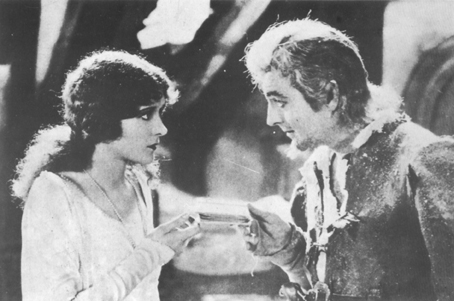
John Barrymore, in the role of the French poet François Villon.
In this vein appeared Mare Nostrum, with Antonio Moreno, a heart-rending film about submarine warfare, and The Four Sons, a story which features a German mother who loses three sons one after another in the bloodbath of Flanders. The fourth, a naturalized American, is the only one to survive. Two of the brothers encounter each other in a crater amidst the hue and cry of battle, each respectively wearing the uniform of the enemy army, with the German already at death's door. This meeting was a profoundly tragic scene and engraved itself on the mind of all who saw the film.
We might point to two war films from this epoch which found their way into the anthologies, The Big Parade and What Price, Glory? Both are in the anti-war bracket. The sufferings of the unknown soldier are explored in these films, a mere statistic hauled off to battle, eking out a bare existence in his sector, always ignorant as to the why and wherefore of the advances and retreats. Reality is the mire of the trenches, the burst of shell fire, the cries of the wounded and the death rattle of the dying. The friend who chokes beside us is suddenly a heap of mangled flesh; and then the girl abandoned to the rearguard, swooning with the anguish of it, an unrealizable dream. Stressed also is the camaraderie of the brothers in arms where social position loses all pertinence.
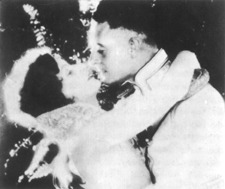
Greta Garbo and John Gilbert, a couple who dazzled Macau, in Anna Karenina.
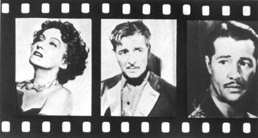
Gloria Swanson, Ronald Colman and Don Ameche.
The battles were reconstructed with a realism never before seen. There on the screen with implacable precision are the explosions of the grenades, the bayonet charges, the death mask of the dying and the wounded crawling in pools of blood. Dolores del Rio (What Price, Glory?) and Renée Adorée (The Big Parade) become the eternal symbols of long-suffering womanhood remaining behind to wait and pray, so often to no avail, for the loved one who departs for the frontline. The sequence in which Renée Adorée is seen walking alongside John Gilbert in a harrowing farewell, as are all good-byes in those circumstances, is one of the high points of The Big Parade and one of the classic farewell scenes of the silent cinema. By reflecting on how the spectator would leave the auditorium completely shattered at the close of the film, and recalling that such films were made without sound and without the help of soundtrack, and bearing in mind that the only medium for expressing the emotions was the gestures and the expression of the eyes and countenance, perhaps we can gain some grasp of the degree of artistic expression the silent cinema had acquired on the eve of the advent of the "talkies". The older generation in Macau even now speak of these two works with respect.
Let us point to another film genre that became a box-office success in the old entertainment hall of the "Vitória", today no longer extant. The tales of the Foreign Legion in the sun-baked Sahara were always food for the imagination. In 1926 came Beau Geste. The Ronald Colman, Neil Hamilton and Ralph Forbes trio were an overnight sensation. The 'talkies' version of Beau Geste, released in the second half of the thirties, this time with Gary Cooper, Ray Milland and Robert Preston, did not improve upon its predecessor, even in the fighting sequences or in the charges of the Bedouin cavalry.
Inspired in Mexico, the silent films gave us three versions of Ramona, one in 1910 with Mary Pickford, one of 1916 with Alda Gleason, and that of 1928 with Dolores del Rio. Macau wept over the last version of the love story in Ramona and the film enjoyed innumerable repeat performances. The South Seas also made themselves felt, principally with The Pagan (Ramon Novarro and Renée Adorée). This film was eternalized by the waltz "Pagan Love Song", which the students of the Lycee Academy used to sing so often on the path-ways of the Vasco da Gama Garden on moonlit nights, accompanied by their ukuleles.
In the last years of the silent period, a sphinx-like countenance of extraordinary beauty impressed itself upon the "Vitória" audiences. That of Greta Garbo, the "Divine". John Gilbert and she were one of the great romantic couples of the cinema, and appeared together in The Flesh and the Devil (1927) and The Woman of Affairs (1928). The torrid love scenes stunned and inflamed the spectators--female viewers on account of Gilbert's manliness, male viewers on account of Garbo's enigmatic sensuality.
Since romantic couples is the theme at hand, it is impossible to overlook Charles Farrell - Janet Gaynor, in the immortal The Seventh Heaven of 1927. The film brought as many tears to the eyes of audiences as Love Story did a few years ago. No couple in cinema history enjoyed as much popularity, devotion and enthusiasm from their "fans" as these two actors. As of The Seventh Heaven, for which Janet Gaynor won the first cinema Oscar for best actress, the public demanded more films in which these two stars appeared together. As regards the silent period, we can cite The Street Angel; the rest belonged to "talkies". In Macau, the young women used to collect any photograph of Farrell and the young men would send letters to Hollywood, requesting shots of Gaynor. Anyone who received such a portrait complete with the autograph of the actress would proudly show it off, to the envy of less fortunate ones. Many youngsters sought to be the Charles Farrell of Macau.
Another film which turned the "Vitória" auditorium into a vale of tears was The Way of All Flesh (1927), with the great German actor Emil Jannings, who was to win the first cinema Oscar for best male actor. We had the opportunity to see the sound version (1939) only, with Akim Tamiroff, and we can confirm that there were no dry eyes in the last half-hour of the film. However, even according to those who enjoyed both versions, the consensus was that if Akim Tamiroff's performance was extraordinary, that of Emil Jannings was superior.
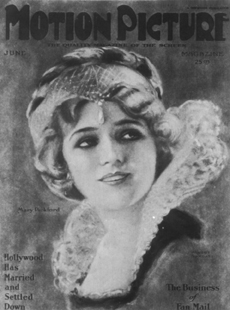
Mary Pickford, the "Sweetheart of the World".
In perusing memories about the actors and films which left most impression on Macau in the silent years, we are caught up in a wave of nostalgia for an easy going and carefree era, in which the cinema was an integral part of our lives, the 'number one' form of entertainment. Nothing symbolizes better this beautiful epoch than those four delightful waltzes inspired by films: Charmaine, from What Price, Glory?, "Diane", from The Seventh Heaven, "Ramona", from the eponymous film, and Pagan Love Song.
Those unacquainted with it might deem the "Vitória" a luxurious and comfortable cinema with fine seating on a par with the magnificent films it exhibited. This impression would but evoke an indulgent smile from those who remember the imposing edifice on the corner of Rua dos Mercadores and Avenida Almeida Ribeiro, one of the coldest spots in Macau on account of the sweeping winds. Designated the first entertainment hall in the absence of any other to overshadow it, it was a veritable monument to discomfort. The Jornal de Macau, May 14th, 1929, in a withering article, described the building in the following terms:
An absolute disaster from the aesthetic point of view, more akin to a warehouse on a busy farmstead than an entertainment hall, with a glass frontispiece, in tin can-like squares, its cement floor, which has never seen the cleaner's mop, serving as a spittoon and a receptacle for all the rubbish that people... drop there during the show, where pools of baby's urine are a not-uncommon sight... since the parents cannot be bothered to take them to the appropriate place, which, in passing, is filthy and sends out a pestilential stench, this super cinema, always so well frequented by the population, who for the want of something better to do, congregate there.
We are constantly besieged by complaints at our desk and a good thing it would be if the manager or managers of that edifice were to take heed of this in order to institute there such up-to-date conditions of hygiene as required by law and bring it on par with its counterparts in Hong Kong. The state it is in is simply not acceptable.
Put an end to that shameful sight once and for all!
The cinemas in Macau are in such a poor state today that this snippet could be applied word for word to all of them.
In bygone days there were no numbers on the tickets in the "Vitória" and whoever arrived earliest obtained the best seats. There was nothing unusual about this. Someone would buy tickets for relatives and friends and deposit handkerchiefs and hats on the seats in order to reserve them for the group or family which was on its way. A system like this was easily abused and as a result there were constant complaints.
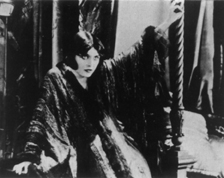
Pola Negri, in Forbidden Paradise.
The most profitable sessions were the matinée performances and those at 7:30 in the evening, attended almost exclusively by the Chinese. Since the majority of the Chinese at the time could not read the English captions accompanying silent films, in the evening session a gentleman would climb into a kind of pulpit on one side of the auditorium and explain the plot out loud in Cantonese. He was a genuine storyteller, a fully-fledged artist. He did not always translate the captions literally. He would throw in expressions of his own and invent dialogues and people listened attentively. When cavalcades, sword fights or big brawls hit the screen, his voice would grow very lively, emphatic and vibrant, like that of a commentator for a horse race or a football match. If the film in question was about ghosts, his voice would grow low-pitched and ghoulish, and he would derive great pleasure from the audience's fear. However, whenever a love scene came up or a farewell scene or a tearful one, his voice would quaver, pausing a while, reverberating in a lyrical tone, appearing to cry in time with the actors.
The last session, that of 9:30 in the evening, peopled mainly by the Portuguese, often ran at a loss unless a blockbuster was having its premiere or the films were exceptional. The matinee perforce belonged to children and students, given that fifty years ago custom had it that children stayed off the street after nightfall. Since there was no soundtrack, it was the image that held the attention. Thus the audience could chat, make comments and laugh aloud without annoying the person seated alongside. 'Talkies' changed all this but the chin-wagging spectator only became a pest once the screen began to emit its miraculous sound. There was a bell signal to call the viewers to attention at the beginning of the sessions. However, when for some mysterious reason this was not working, an usher would have to dash to the door to ring a handbell. Once the youngsters had stolen the bell clapper, knowing full well that the bell signal would break down, the usher had no option but to bellow his lungs out calling the people inside.
The matinee public, a young crowd, preferred serial films, and in particular cowboy serials. The hero's final cavalcades to save the poor death-bound or rape-bound victim were accompanied by shouts from the spectators, who stamped their feet and jumped up and down in their seats, heart in mouth. Those who could speak English would yell in chorus: "Come on Tim McCoy! Come on Tom Mix!" Others could manage only a word: "Quick... quick...." Still others: "Don't give up, boy!" In the brawl scenes, when the hero would deliver the customary winning blow, the enthusiasm voiced itself with expressions such as: "That's the one, boyo!," "oh my, a good one," "clever lad, by deuce."
During tearjerkers and melodramas, the sobs could be clearly heard in the middle of the stunned silence of the auditorium. And the girls sighing over their favourite actors. One recollection has it that one young woman, now advanced in years, could not contain herself on beholding Charles Farrell's face in close-up in the film Seventh Heaven, and audibly whispered between tears, in local patois: "Qui amochai!..." (What a sweetheart!)
For the poorest cinema-goers there was what was called the "back-stage", behind the screen itself. Of course, what they saw in effect were the captions in reverse and a host of left-handed actors. The hard and narrow seats were jammed together and extremely uncomfortable. When physiological needs prevailed, people passed water right there onto the earth floor which soaked everything up.
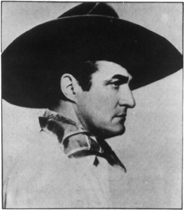
Tom Mix, the cowboy who thrilled Macau audiences.
The "back-stage" was also the haunt of young men, not on account of poverty but because they had spent their pocket-money (in those days, having a silver pataca coin made you the 'cock of the walk') and the upshot was recourse to these unlikely quarters. The chance to see a thrilling episode with Douglas Fairbanks or Tom Mix was worth the sacrifice of going back-stage. The ticket cost at most five avos. Even so, the young men devised all kinds of strategies to slip in for free. They would go in a group. Everybody would pool together their coppers to make five avos (five avos amounted to more than half a dozen copper coins, the so-called sens). One member of the group would purchase the ticket and await the beginning of the film back-stage. As soon as the lights went out and the usher momentarily disappeared, this member would open a nearby window and the rest of the group would dive in rapidly from the street. When they boarded the window up to put a stop to this racket, some continued to slip in for free. The group would cluster round the usher, having bought one or two tickets, and would all speak at once at the tops of their voices. When the man's attention had been distracted and he no longer knew whom to attend first, the most daring and nimble members of the group would slide their way in unnoticed. In the end, the usher would grow tired of the confusion and allow everybody through with all the resignation of a father letting his sons off for their mischief.
A pianist would play in the matinées and the second evening sessions (9:30), before the beginning of the programme, in the intervals if there were any, and during the films when needed. We can only remember two names, that of Joneca Franco and that of Sr. Adito. The most popular of the two seems to have been Sr. Adito, who could pound out a vast repertoire. When sentimental sequences came up on screen, he would play sentimental music. When the gallop sequences or brawls held the stage, he would launch into military marches or, what else, the Overture to William Tell. During blood-curdling and macabre scenes, the piano would wax funereal, sending forth its sepulchral chords. When Lon Chaney strode on screen with his terrible mask, the piano itself would fall silent, petrified with fear.
In the intervals, paper balls, olive stones and almond shells would rain down upon Sr. Adito. Sometimes he would stoically put up with these affronts, at others he would glance over his shoulder with a furious expression in his eyes, and exclaim rancorously:
"Where are your manners!..."
The situation resolved itself when the management set up a partitioning screen to protect the pianist from the little devils in the matinée. With an audience of a different ilk and minus the partition, Sr. Adito was someone else altogether in the evening session. He knew the clientele and would accept requests: "Adito, play this..., Adito, play the other." Smiling and happy to oblige, with an ever-ready "OK" on his lips, just the man for the job, he would freely comply to the pleasure of the auditorium, which was never short of sincere applause.
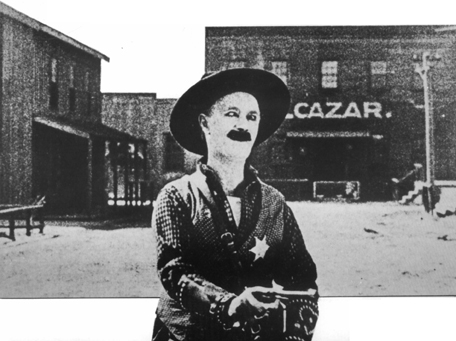
Ben Turpin, the burlesque cowboy and one of the first professional actors of motion pictures.
In spite of its monumental defects, the "Vitória" made every effort to satisfy its audiences with a varied programme. Today, the movie houses offer the film of the day and nothing else, save trailers for future films. Newsreel, cartoons and documentary shorts are no longer shown prior to the film itself. Both Macau and Hong Kong have adopted a similar system, because cinemas no longer make the effort to serve their clientele and the onus is rather on profits.
A case in point is the programme for the "Vitória" on February 2nd, 1927:
1 - Charlie Chaplin, a comedy in 2 parts.
2 - Richard Dix in Manhattan, high comedy in 8 parts.
3 - William Desmond and Eilees Sedowick in Riddle of Rider. An adventure serial film in 15 episodes and 30 parts - episode 8 in 2 parts.
And the programme for February 3rd and 4th, 1929, one year later:
1 - Paramount News No. 26.
2 - Ben Turpin in The Real Virginia, a special comedy in 2 parts.
3 - Carl Laemmie presents Francis X. Bushman and Anna Q. Nilsson in The 13th Juror, a drama in 7 great parts.
4 - Antonio Moreno in The Veiled Mystery, an adventure serial film in 15 episodes and 30 parts - episode 8 in 2 parts.
The announcements and the programme were drawn up with a certain degree of care. As an example, let us cite Stella Dallas, a great drama in two parts, with Ronald Colman, Belle Bennett, Alice Joyce, etc., of March 4th, 1928:
Stella Dallas is the story of a world famous woman, victim to human vanity and selfishness, who spent hour upon hour in excruciating moral torment, a woman who wept in vain over her own demise, helplessly watching herself flung headlong down 'skid row', that 'skid row' called Life, so full of pain, bitterness and disillusion....

Lon Chaney, in The Hunchback of Notre Dame.
And then there is the programme of March 17th, 1927, for a Lon Chaney film, the stupendous and marvelous production Unholy Tree, an eight-part drama:
In this singular drama, the great Chaney plays the role of a famous professor of ventriloquism who, with the help of his two companions, one a giant and the other a dwarf, turns felon, robbing and pillaging wealthy figures - and, of the many horrendous crimes he carried out, the one to be discovered by the police was a hideous murder. The crime was attributed to a young man. Human justice, blind as ever, sentenced him to death. At the very moment in which the innocent accused is about to pay for the crime of another, the true murderer is possessed by a remorse which impels him to confess all, and... the epilogue reveals a turnabout moving beyond words.
The mere mention of the name Lon Chaney in this superlative film suffices to bring across the artistry and uniqueness of the film, which was a great box office success in all the major cinemas to exhibit it.
Another programme on March 27th 1927:
The Small Bachelor.
Dramatic comedy - eight-parts.
Protagonists: André Beranger and Barbara Kent.
Synopsis:
A merry film. The plot will certainly please you. He is in love... She is in love... Her parents are in uproar. What a situation!. After so many mishaps and setbacks, our young couple were lucky enough to overcome all the obstacles in their way... and marry. André Beranger and Barbara Kent are new to audiences, but we are convinced that the flair they show in their respective roles, which were bestowed upon them by the famed production house 'Universal', puts them on a par with other contemporary stars of cineworld.
In 1927, the cinematograph "Long Tin Mong Toi" appeared on the scene, threatening to wrest the laurels from the "Vitória". It was situated on the corner of Avenida Conselheiro Ferreira de Almeida and Avenida Horta e Costa, which backed onto the Lou Cao's gardens, then at the height of their original beauty. The cinematograph belonged to Lou Cao's oldest son, the gallant and worthy Lou Lim Ioc. This movie house was considered part of the outskirts, yet was equipped with better machinery and fittings than the "Vitória". Such did our illustrious Chinese fellow advertise his cinematograph:
Two sessions per evening, one at 7:00 and one at 9:30, the last session being accompanied by a piano. All the latest equipment, with the clearest and strongest reproduction. The latest films, with many colourful scenes, comfortable seating, clean air, with ceiling and hand-operated ventilation.
For its opening night it billed Monsieur Beaucaire (Rudolph Valentino and Bebe Daniels), a film which would only reach the "Vitória" a month later. It made its mark subsequently with serial films, especially Westerns, Jack Hoaxie being the favourite star.
The "Long Tin Mong Toi", very popular although somewhat ahead of its time, was shortlived. The premature and unexpected death of its patron, on July 17th, 1927, which came as a shock to the city, delivered the fatal blow to this movie house. In the absence of its founder, it closed its doors to the public soon after. This spelled the premature end, within a short time of its birth, of a fine endeavour, a fate that befell other undertakings which drew on the spirit of Lou Lim Ioc.
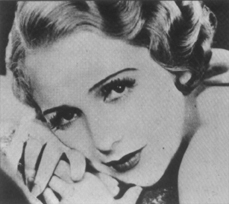
Bebe Daniels. On the screens of Macau, she co-starred with Valentino.
NB. This text, under an adapted title, is an updated compilation of a series of chronicles originally published by the author in the newspaper "Confluência" (ADIM), in 1975. The reader should be forewarned that some phrases are thus rendered in the present indicative. In the next edition, we will be publishing the next installment of the as yet unpublished edition, the author's history of cinema in Macau. All illustrations of announcements included were chosen by us from the newspapers A Verdade and Combate, published in Macau between 1909 and 1927.
* Law Graduate (Univ. of Coimbra). Researcher, chronicler and novelist. Author of Amor e Dedinhos de Pé (Love and Toes), (3rd ed. in 4 years), recently adapted for cinema.